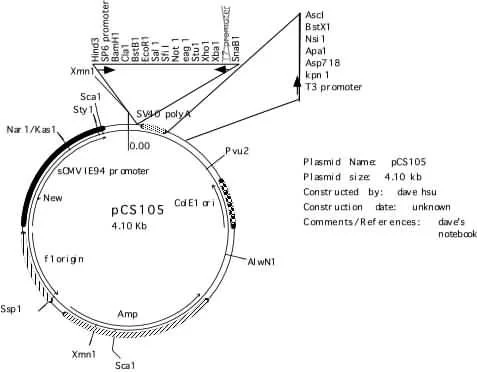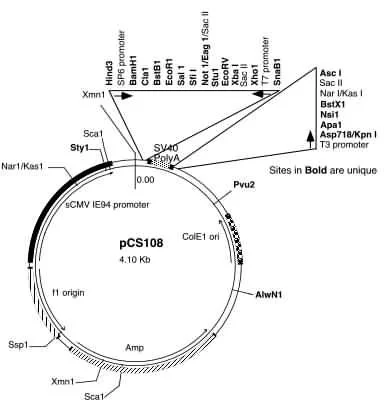Vector Information for Full Length Libraries
There is a considerable effort underway to generate a unique full length library in Xenopus for expression analysis. Given the genomic resources available for X. tropicalis, this effort has focused on X. tropicalis clones. Clones in this library may be in one of the following expression vectors. All pCS10x vectors are a derivative of pCS105 which originally was modified from CS2+. pCS105 is included for reference.
pCS105
pCS105 is a derivative of CS2+ modified by Dave Hsu to make it compatible with the Superscript kit. It introduces salI and notI sites. Also creates an AscI site downstream of the SV40 poly A signal for linearizing the clone. Sp6 can be used to generate sense RNA. NOTE: T7 is defective. To make antisense, use T3. For additional info on CS105 (PDF). For CS2 information, please see Dave Turner's site.
pCS107
Julie Baker modified pCS105 to make the T7 promoter functional for making antisense RNA and created pCS107. As a result, the XbaI site at the end of the polylinker was destroyed. Additional info (PDF).
pCS108
Mustafa Khokha modified pCS107 by cloning a linker at the end of the MCS that created EcoRV, XbaI, and SacII sites and generated pCS108. This facilitated cloning of constructs from CS2 or CS105 (which have XbaI sites) into a pCS10x vector with a functional T7 promoter. Additional info (PDF).
pCS110K
In collaboration with Curtis Altmann and Mustafa Khokha, Maura Lane created pCS110K. This vector uses Invitrogen's Gateway technology for direct cloning of constructs from source vectors (such as pSport6) into pCS110K using a simple and highly effective in vitro recombination reaction (BP recombination) that is independent of available restriction sites. NOTE: kanamycin resistance and ccdB negative selection. Plasmid must be grown in ccdb 3.1 cells (Invitrogen) or an appropriate substitute. Successful recombinants are now entry vectors and can be directly cloned into Gateway destination vectors. For additional info (PDF). For information on Gateway technology see the Invitrogen website. NOTE: in a single analysis, pCS110K appears to make functional mRNA but appears slightly less potent than similar mRNA made in either pSport6 or pCS10x.
pCS111
Mustafa Khokha modified pCS108 by cloning a linker between the EcoRI and NotI sites eliminating the SfiI site and creating a SmaI site. This creates a vector suitable for cloning cDNAs using the methods from the XGC. Additional info (PDF).
pSport6
Designed by Invitrogen and takes advantage of Gateway technology for easy transfer of inserts into different vectors. It has a number of features that makes it possible to use it for expression studies such as an Sp6 promoter at the 5' end and a SV40 polyA signal at the 3' end. Unfortunately, the most useful restriction site for linearizing the clone to prevent unnecessary transcription of vector sequence is ClaI which is estimated to be present at least once in 12% of inserts. Also ClaI is blocked by overlapping dam methylation so to use ClaI the vector must be prepared from a dam- strain of bacteria (library strains are dam+). Once this is done, pSport6 does appear to make functional mRNA that is nearly as potent as the pCS10x vectors. Additional info on pSport6 can be found on the Invitrogen website.





